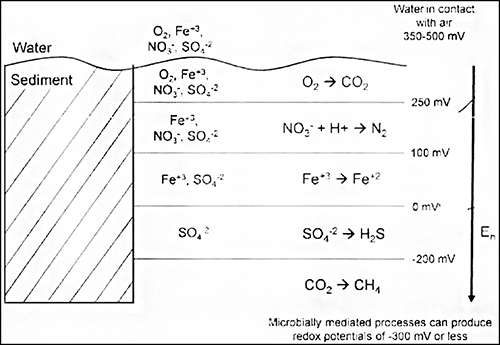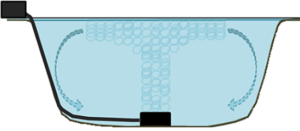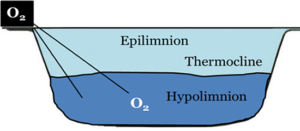Oxygen Debt in Your Lake or Pond
Oxygen debt is the difference between the amount of oxygen your lake or pond needs each day to stay in balance vs what it has. When your dissolved oxygen meter reads 0 mg/L, we know there is a problem. Unfortunately, a meter cannot tell you how much oxygen debt the lake is in.
Oxygen meters can only go as low as 0 mg/L. For instance, if daily oxygen demand is 100kg oxygen, and 80kg is added per day, then each day you have 20kg of oxygen debt. The more oxygen debt the waterbody goes into, the higher the risk of problems including cyanobacteria, odors, fish kills, and more.
Measuring Oxygen Debt
 A common method to measure oxygen debt in your waterbody is with a redox probe, which can tell us what the dominant electron acceptor is being used in lake respiration. Redox values, in volts (V) or millivolts (mV) provide an estimate of how oxidizing or reducing an environment is.
A common method to measure oxygen debt in your waterbody is with a redox probe, which can tell us what the dominant electron acceptor is being used in lake respiration. Redox values, in volts (V) or millivolts (mV) provide an estimate of how oxidizing or reducing an environment is.
Redox values in nature often range from -300mV to 500mV. The higher the value the more oxidized the environment and the better your lake chemistry will be. If your oxygen probe is reading 0 mg/L and your redox probe is reading -150 mV you have a significant oxygen debt to overcome.
What we can do to overcome oxygen debt
Many lake managers would agree that maintaining > 5-6 mg/L oxygen or redox values above 300 mV is ideal and will support all desired uses for the lake. How do we achieve these levels 365 days a year and get out of oxygen debt? The two fundamental ways to add oxygen to water have both advantages and disadvantages.
- Artificially mix water to prevent density layers and stratification, and oxygen depletion
- Add oxygen to the bottom water (i.e., hypolimnion) at a rate that will counter the lake’s oxygen demand
There are a variety of devices available that can achieve these fundamental objectives. These two are among the most effective.
Bottom Diffused Aeration
Compressed air injected into the bottom waters of a lake through diffusers is the most economical approach. Bottom diffused Aeration increases circulation to artificially destratify the lake daily. This will maintain oxygen levels close to saturation.

We calculate aeration sizing by computing the number of turnovers per day needed. We define it by the % water that moves per day. For example, 0.8 turnovers are equivalent to moving 80% of the target water per day. Most designs achieve at least one full turnover per day. Turnover is directly related to oxygen transfer and how bad the water quality is.
The intense mixing induced from injecting air also provides some direct physical advantages in combating algae issues. For instance, mixing favors algal species, like diatoms, that need mixing currents to remain suspended in the upper water column.
Hypolimnetic Oxygenation
Mixing and artificial destratification are not the answer for all lakes and ponds. Hypolimnetic oxygenation is best for certain conditions. These include cold water fisheries and lakes suspected to have background soils high in clay. This type of system is more expensive since you must generate all the oxygen from the device but it has advantages for certain applications.

Hypolimnetic oxygenation, as the name implies, injects dissolved oxygen to the hypolimnion using an oxygen generating device. No bubbles form as all the oxygen dissolves in the water before it reaches the hypolimnion. This is an important design specification since our goal is to keep the hypolimnion intact with cold water.
All waterbodies need oxygen to thrive. How you achieve the right balance requires a careful consideration of the requirements of each specific lake or pond.
Is your lake or pond showing signs of having an oxygen debt?
Vertex Aquatic Solutions, founded in 1977, is the professionals’ choice for research based scientific consulting services, aeration systems, floating fountains, bubble curtains and biological products to enhance water quality in lakes, ponds, canals, marinas and reservoirs. As respected leaders in the lake management industry the Vertex team of aquatic biologists, limnologists, fisheries scientists and engineers work together to deliver science-based, environmentally sound solutions to complex waterbody issues. Our products and services are delivered through an international network of qualified, experienced waterbody professionals who provide local support, service and pond management expertise to customers.
← Previous